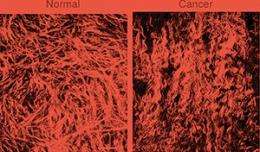Spotting ovarian cancer, before it's too late

(Medical Xpress)—At just 28 percent, the five-year survival rate for women diagnosed with ovarian cancer is much lower than in other cancer cases. And, the disease can easily go unnoticed, making it difficult to find effective treatments. "There are very few symptoms associated with ovarian cancer," says Biomedical Engineering Associate Professor Paul Campagnola. "When it gets detected, it's usually too late."
While his colleagues work to find the most efficient therapies for patients in the later stages of the disease, Campagnola and his students are using more nuanced analysis of tissue imaging to diagnose ovarian and breast cancer earlier. Understanding what tissue changes preclude the development of certain cancers could help doctors diagnose ovarian cancer eariler and give patients a wider window in which to seek treatment. "We're trying to develop a physical and biochemical understanding of the changes that happen as cancer develops," says Campagnola.
The key lies in understanding the extracellular matrix (ECM), the tissue made up of collagen and elastin that essentially holds the body together. The ECM supports all organs, including the skin. "It's increasingly recognized that there are changes in the collagen—particularly in the extracellular matrix—that accompany almost all cancers," says Campagnola. "Almost all cancers are epithelial—that's the top layer of cells—but they interact with the tissue below it."
Modeling how cancers can dictate the types and concentration of different collagens in the ECM nearby, Campagnola hopes to identify less common "collagen isoforms" as markers that could be used to screen women at risk for ovarian cancer regularly, improving their odds of an early diagnosis.
Campagnola and his students are developing a combination of optics and imaging techniques that could improve the odds an ovarian cancer patient has at survival. And they are imaging different mixtures of known collagen types with a variety of techniques to see if they can differentiate between normal and abnormal ECM structure. That, says Campagnola, is key to an accurate diagnosis.















